Mixed-Phase Ion-Exchangers from Waste Amber Container Glass
Abstract
:1. Introduction
2. Materials and Methods
2.1. Materials
2.2. Hydrothermal Synthesis and Characterisation of Zeolites
2.3. Uptake of Pb2+ and Cd2+ Ions by the Zeolite Products
3. Results
3.1. Characterisation of the Zeolite Products
3.2. Ion-Exchange Properties of the Zeolite Products
4. Discussion
5. Conclusions
Author Contributions
Funding
Institutional Review Board Statement
Informed Consent Statement
Data Availability Statement
Acknowledgments
Conflicts of Interest
Appendix A
Characterisation of the Amorphous Aluminium Hydroxide Waste
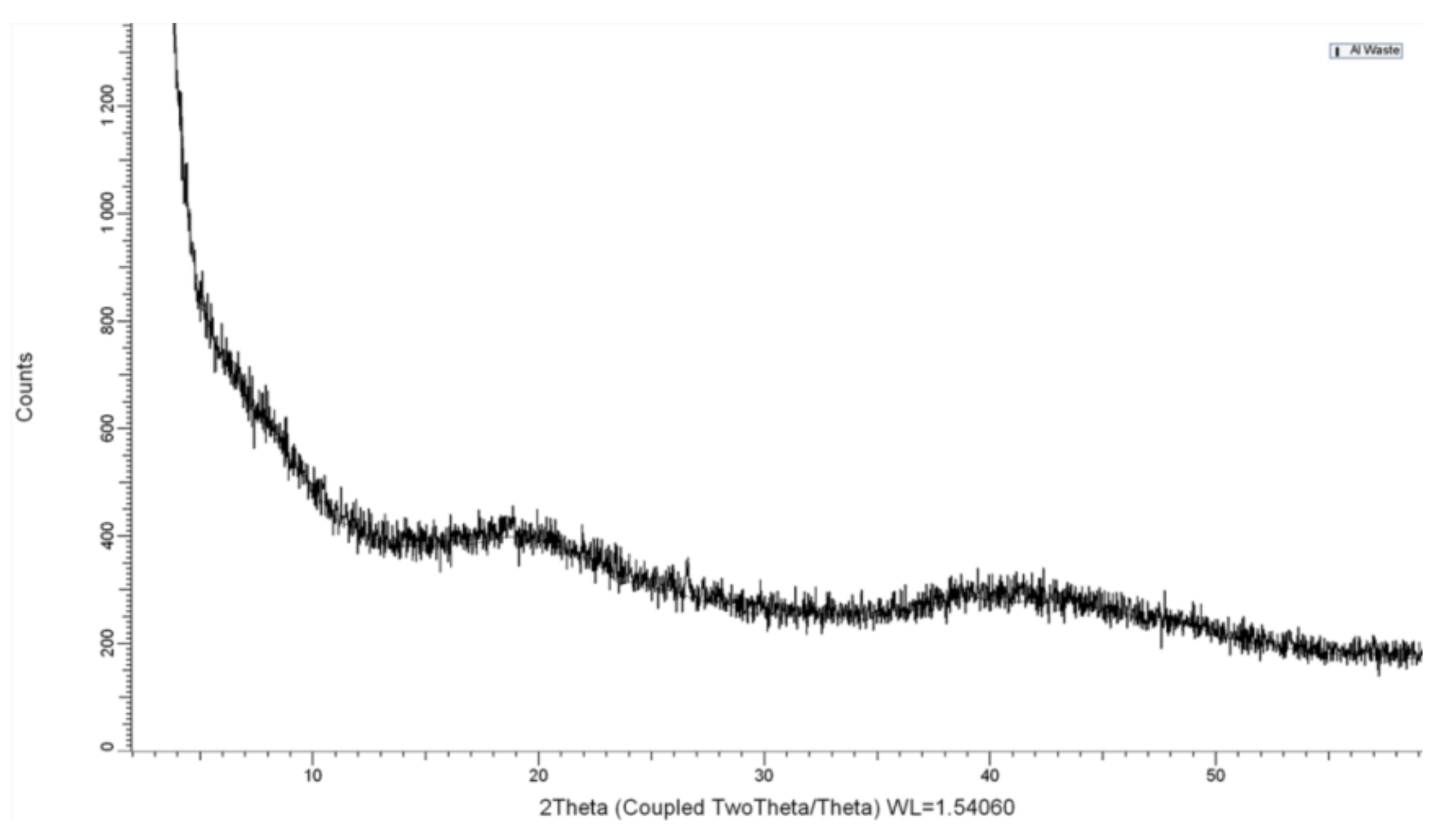
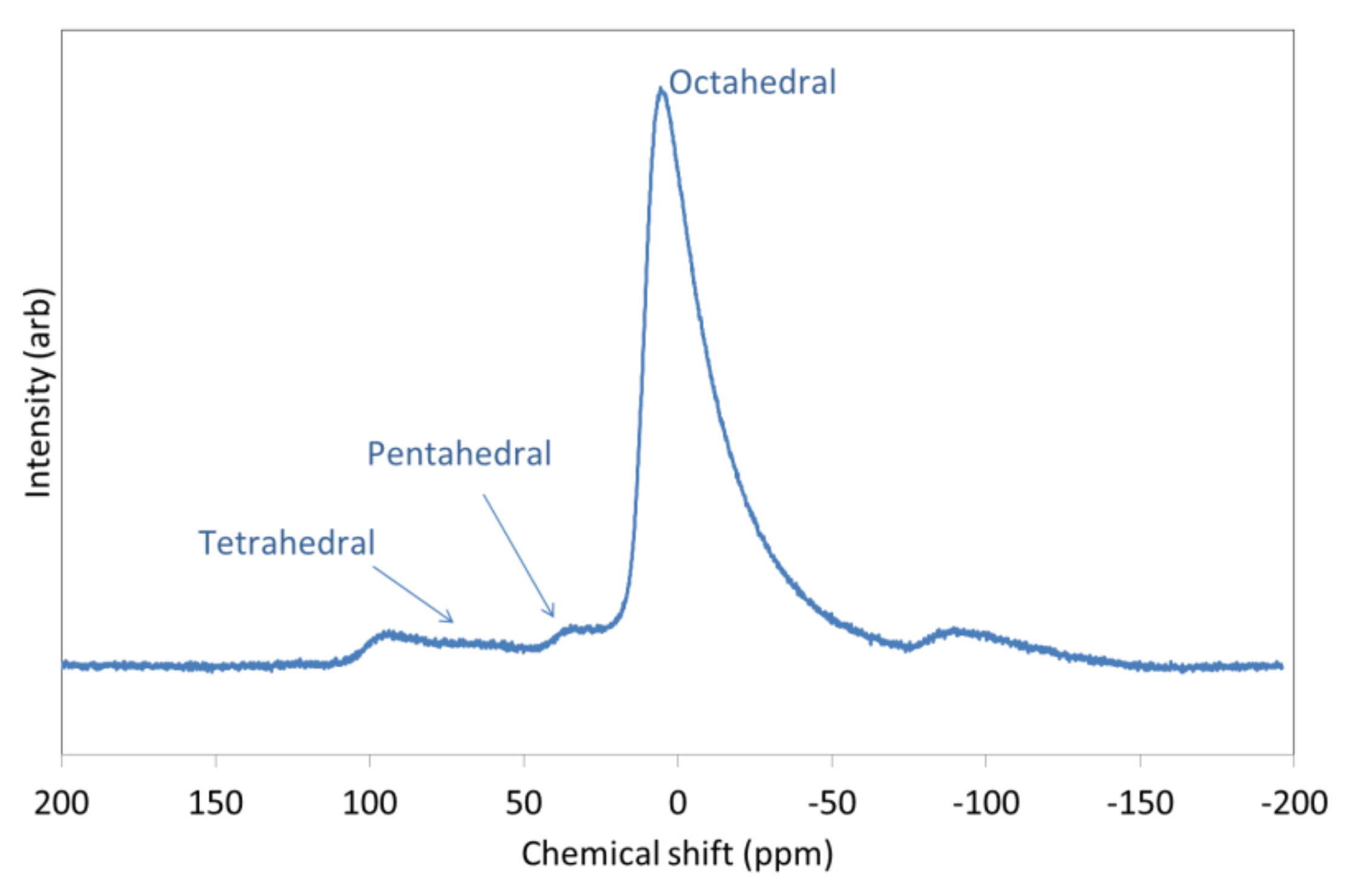
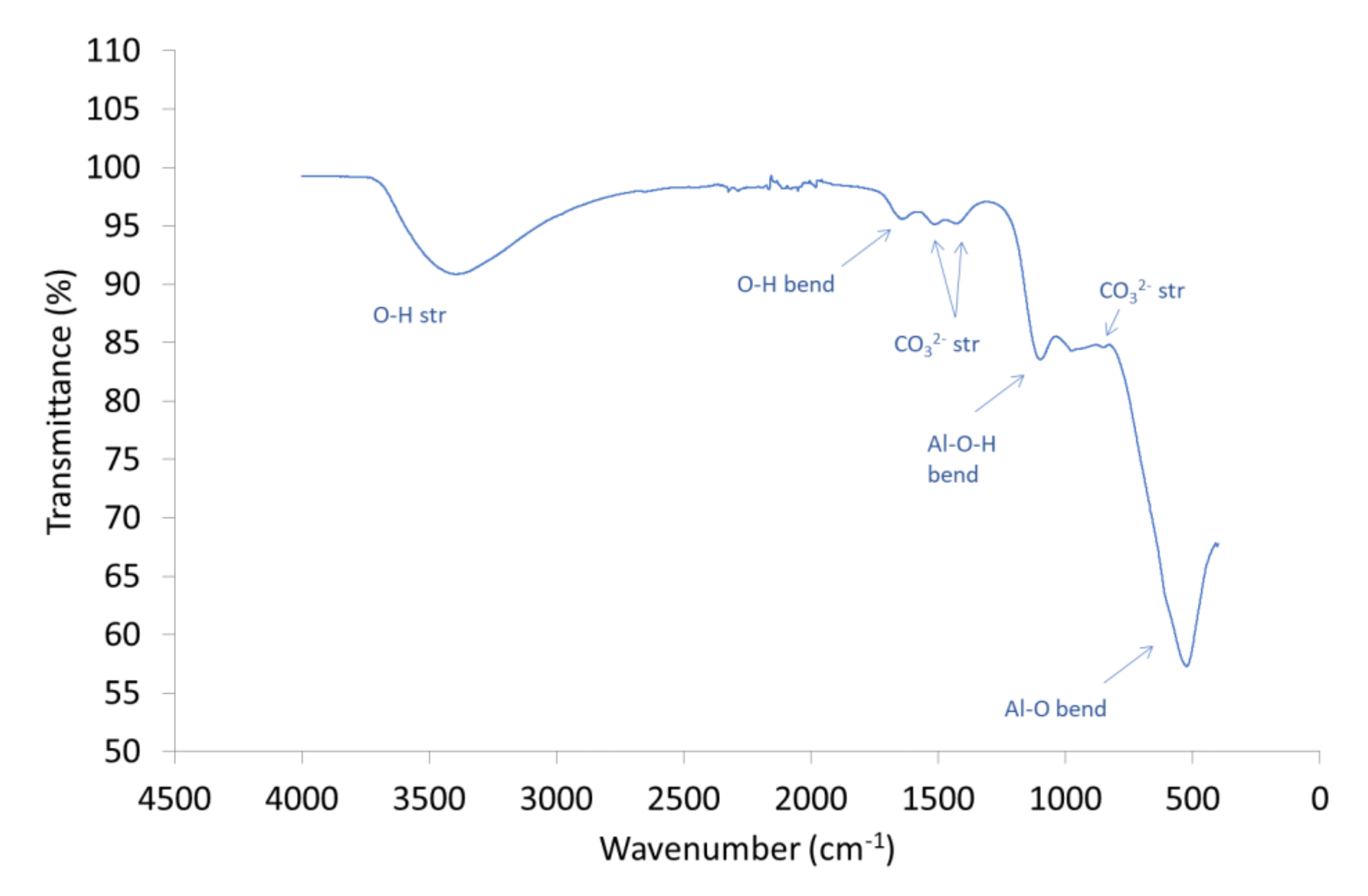
References
- Jiang, Y.; Ling, T.C.; Mo, K.H.; Shi, C. A critical review of waste glass powder—Multiple roles of utilization in cement-based materials and construction products. J. Environ. Manag. 2019, 242, 440–449. [Google Scholar] [CrossRef]
- Conradt, R. Prospects and physical limits of processes and technologies in glass melting. J. Asian Ceram. Soc. 2019, 7, 377–396. [Google Scholar] [CrossRef] [Green Version]
- Coleman, N.J. 11 Å tobermorite ion exchanger from recycled container glass. Int. J. Environ. Waste Manag. 2011, 8, 366–382. [Google Scholar] [CrossRef]
- Majdinasab, A.; Yuan, Q. Post-consumer cullet and potential engineering applications in North America. Resour. Concerv. Recy. 2019, 147, 1–9. [Google Scholar] [CrossRef]
- Heriyanto; Pahlevani, F.; Sahajwalla, V. From waste glass to building materials—An innovative sustainable solution for waste glass. J. Clean. Prod. 2018, 191, 192–206. [Google Scholar] [CrossRef]
- Majdinasab, A.R.; Yuan, Q. Microwave synthesis of zeolites from waste glass cullet using indirect fusion and direct hydrothermal methods: A comparative study. Ceram. Int. 2019, 45, 2400–2410. [Google Scholar] [CrossRef]
- Majdinasab, A.R.; Manna, P.K.; Wroczynskyj, Y.; van Lierop, J.; Cicek, N.; Tranmer, G.K.; Yuan, Q. Cost-effective zeolite synthesis from waste glass cullet using energy efficient microwave radiation. Mater. Chem. Phys. 2019, 221, 272–287. [Google Scholar] [CrossRef]
- Majdinasab, A.R.; Yuan, Q. Microwave synthesis of zeolites from waste glass cullet using landfill leachate as a novel alternative solvent. Mater. Chem. Phys. 2019, 223, 613–622. [Google Scholar] [CrossRef]
- Elmes, V.K.; Edgar, B.N.; Mendham, A.P.; Coleman, N.J. Basic metallosilicate catalysts from waste green container glass. Ceram. Int. 2018, 44, 17069–17073. [Google Scholar] [CrossRef]
- Silva, R.V.; de Brito, J.; Lye, C.Q.; Dhir, R.K. The role of glass waste in the production of ceramic-based products and other applications: A review. J. Clean. Prod. 2017, 167, 346–364. [Google Scholar] [CrossRef]
- Ayala Valderrama, D.M.; Gómez Cuaspud, J.A.; Roether, J.A.; Boccaccini, A.R. Development and characterization of glass-ceramics from combinations of slag, fly ash, and glass cullet without adding nucleating agents. Materials 2019, 12, 2032. [Google Scholar] [CrossRef] [Green Version]
- Bobirică, C.; Shim, J.-H.; Park, J.-Y. Leaching behavior of fly ash-waste glass and fly ash-slag-waste glass-based geopolymers. Ceram. Int. 2018, 44, 5886–5893. [Google Scholar] [CrossRef]
- Giro-Paloma, J.; Barreneche, C.; Maldonado-Alameda, A.; Royo, M.; Formosa, J.; Inés Fernández, A.; Chimenos, J.M. Alkali-activated cements for TES materials in buildings’ envelops formulated with glass cullet recycling waste and microencapsulated phase change materials. Materials 2019, 12, 2144. [Google Scholar] [CrossRef] [Green Version]
- Taylor, J.H.; Elmes, V.E.; Hurt, A.P.; Coleman, N.J. Synthesis of feldspathoids and zeolite K–F from waste amber container glass. Mater. Chem. Phys. 2020, 246, 122805. [Google Scholar] [CrossRef]
- Elmes, V.E.; Mendham, A.P.; Coleman, N.J. A waste-derived lithium metasilicate basic catalyst. MATEC Web Conf. 2017, 109, 03004. [Google Scholar] [CrossRef]
- Ashby, M.F. Materials and the Environment (Eco-informed Material Choice), 2nd ed.; Butterworth-Heinemann: Oxford, UK, 2013. [Google Scholar] [CrossRef]
- Coleman, N.J.; Li, Q.; Raza, A. Synthesis, structure and performance of calcium silicate ion exchangers from recycled container glass. Physicochem. Probl. Miner. Process. 2014, 50, 5–16. [Google Scholar] [CrossRef]
- Coleman, N.J.; Trice, C.J.; Nicholson, J.W. 11 Å tobermorite from cement bypass dust and waste container glass: A feasibility study. Int. J. Miner. Process. 2009, 93, 73–78. [Google Scholar] [CrossRef]
- Majdinasab, A.; Yuan, Q. Synthesis of Al-substituted 11Å tobermorite using waste glass cullet: A study on the microstructure. Mater. Chem. Phys. 2020, 250, 123069. [Google Scholar] [CrossRef]
- Coleman, N.J.; Hurt, A.P.; Raza, A. Hydrothermal synthesis of lithium silicate from waste glass. A preliminary study. Physicochem. Probl. Miner. Process. 2015, 51, 685–694. [Google Scholar] [CrossRef]
- Terzano, R.; D’Alessandro, C.; Spagnuola, M.; Romagnoli, M.; Medici, L. Facile zeolite synthesis from municipal glass and aluminium solid wastes. Clean-Soil Air Water 2015, 43, 133–140. [Google Scholar] [CrossRef]
- Espejel-Ayala, F.; Chora Corella, R.; Morales Pérez, A.; Pérez-Hernández, R.; Ramírez-Zamora, R.M. Carbon dioxide capture utilizing zeolites synthesized with paper sludge and scrap-glass. Waste Manag. Res. 2014, 32, 1219–1226. [Google Scholar] [CrossRef]
- Lin, C.; Wang, D.; Ye, S. Synthesis of micro-mesoporous glass-analcime composite structure with soda-lime-silica glass as raw material. Funct. Mater. Lett. 2019, 12, 1950021. [Google Scholar] [CrossRef]
- Maisuria, J.; Elmes, V.K.; Hurt, A.P.; Coleman, A.A.; Coleman, N.J. Hydrothermal synthesis of zeolites from green container glass. Physicochem. Probl. Miner. Process. 2020, 56, 784–796. [Google Scholar] [CrossRef]
- Collins, F.; Rozhkovskaya, A.; Outram, J.G.; Millar, G.J. A critical review of waste resources, synthesis, and applications for Zeolite LTA. Microporous Mesoporous Mater. 2020, 291, 109667. [Google Scholar] [CrossRef]
- Franus, M.; Wdowin, M.; Bandura, L.; Franus, W. Removal of environmental pollutions using zeolites from fly ash: A review. Fresenius Environ. Bull. 2015, 24, 854–866. [Google Scholar]
- Buhl, J.-C.; Löns, J. Synthesis and crystal structure of nitrate enclathrated sodalite Na8[A1SiO4]6(NO3)2. J. Alloys Compd. 1996, 235, 41–47. [Google Scholar] [CrossRef]
- Buhl, J.-C.; Stief, F.; Fechtelkord, M.; Gesing, T.M.; Uwe Taphorn, U.; Taake, C. Synthesis, X-ray diffraction and MAS NMR characteristics of nitrate cancrinite Na7.6[AlSiO4](NO3)1.6(H2O)2. J. Alloys Compd. 2000, 305, 93–102. [Google Scholar] [CrossRef]
- Dyballa, M.; Obenaus, U.; Lang, S.; Gehring, B.; Traa, Y.; Koller, H.; Hunger, M. Brønsted sites and structural stabilization effect of acidic low-silica zeolite A prepared by partial ammonium exchange. Micropor. Mesopor. Mater. 2015, 212, 110–116. [Google Scholar] [CrossRef]
- Coleman, N.J. Interactions of Cd(II) with waste-derived 11 Å tobermorites. Sep. Purif. Technol. 2006, 48, 62–70. [Google Scholar] [CrossRef]
- Coleman, N.J.; Lee, W.E.; Slipper, I.J. Interactions of aqueous Cu2+, Zn2+ and Pb2+ ions with crushed concrete fines. J. Hazard. Mater. 2005, 121, 203–213. [Google Scholar] [CrossRef] [PubMed]
- Ma, Z.; Xue, R.; Li, J.-s.; Zhao, Y.; Xue, Q.; Chen, Z.; Wang, Q.; Poon, C.S. Use of thermally modified waste concrete powder for removal of Pb(II) from wastewater: Effects and mechanism. Environ. Pollut. 2021, 277, 116776. [Google Scholar] [CrossRef]
- Panek, R.; Medykowska, M.; Wiśniewska, M.; Szewczuk-Karpisz, K.; Jędruchniewicz, K.; Franus, M. Simultaneous removal of Pb2+ and Zn2+ heavy metals using fly ash Na-X zeolite and its carbon Na-X(C) composite. Materials 2021, 14, 2832. [Google Scholar] [CrossRef]
- Medina, T.J.; Arredondo, S.P.; Corral, R.; Jacobo, A.; Zárraga, R.A.; Rosas, C.A.; Cabrera, F.G.; Bernal, J.M. Microstructure and Pb2+ adsorption properties of blast furnace slag and fly ash based geopolymers. Minerals 2020, 10, 808. [Google Scholar] [CrossRef]
- Liu, S.; Cui, S.; Guo, H.; Wang, Y.; Zheng, Y. Adsorption of lead ion from wastewater using non-crystal hydrated calcium silicate gel. Materials 2021, 14, 842. [Google Scholar] [CrossRef] [PubMed]
- Franus, M.; Bandura, L. Sorption of heavy metal ions from aqueous solution by glauconite. Fresenius Environ. Bull. 2014, 23, 825–839. [Google Scholar]
- Nguyen, T.C.; Loganathan, P.; Nguyen, T.V.; Kandasamy, J.; Naidu, R.; Vigneswaran, S. Adsorptive removal of five heavy metals from water using blast furnace slag and fly ash. Environ. Sci. Pollut. Res. 2018, 25, 20430–20438. [Google Scholar] [CrossRef] [Green Version]
- Taamneh, Y.; Al Dwairi, R. The efficiency of Jordanian natural zeolite for heavy metals removal. Appl. Water. Sci. 2013, 3, 77–84. [Google Scholar] [CrossRef] [Green Version]
- Elmes, V.K.; Coleman, N.J. Interactions of Cd2+, Co2+ and MoO42− Ions with Crushed Concrete Fines. J. Compos. Sci. 2021, 5, 42. [Google Scholar] [CrossRef]
- Yarusova, S.B.; Gordienko, P.S.; Yudakov, A.A.; Azarova, Y.A.; Yashchuk, R.D. Kinetics of the sorption of heavy-metal ions by a sorbent obtained from boric acid production waste. Theor. Found Chem. Eng. 2016, 50, 841–845. [Google Scholar] [CrossRef]
- Gordienko, P.S.; Yarusova, S.B.; Suponina, A.P.; Yakimenko, L.V. Sorption of Cd2+ ions by silicate materials of different origins. Russ. J. Gen. Chem. 2013, 82, 2709–2714. [Google Scholar] [CrossRef]
- Díaz-Ortiz, A.; de la Hoz, A.; Alcázar, J.; Carrillo, J.R.; Herrero, M.A.; Muñoz, J.M.; Prieto, P.; de Cózar, A. Reproducibility and scalability of microwave-assisted reactions. In Microwave Heating; Usha Chandra, U., Ed.; IntechOpen Ltd.: London, UK, 2011; pp. 137–162. [Google Scholar] [CrossRef]
- Dąbrowska, S.; Chudoba, T.; Wojnarowicz, J.; Łojkowski, W. Current trends in the development of microwave reactors for the synthesis of nanomaterials in laboratories and industries: A review. Crystals 2018, 8, 379. [Google Scholar] [CrossRef] [Green Version]
- Kumar, R.; Bhaumik, A.; Ahedi, R.K.; Ganapathy, S. Promoter-induced enhancement of the crystallization rate of zeolites and related molecular sieves. Nature 1996, 381, 298–300. [Google Scholar] [CrossRef]
- Bosnar, S.; Antonić-Jelić, T.; Bronić, J.; Krznarić, I.; Subotić, B. Influence of anions on the kinetics of zeolite A crystallization: A population balance analysis. J. Cryst. Growth 2004, 267, 270–282. [Google Scholar] [CrossRef]
- Temuujin, J. Mechanochemical treatment of solid mixtures—a promising way of synthesizing ceramic precursors. Chem. Sustain. Dev. 2001, 9, 589–595. [Google Scholar]
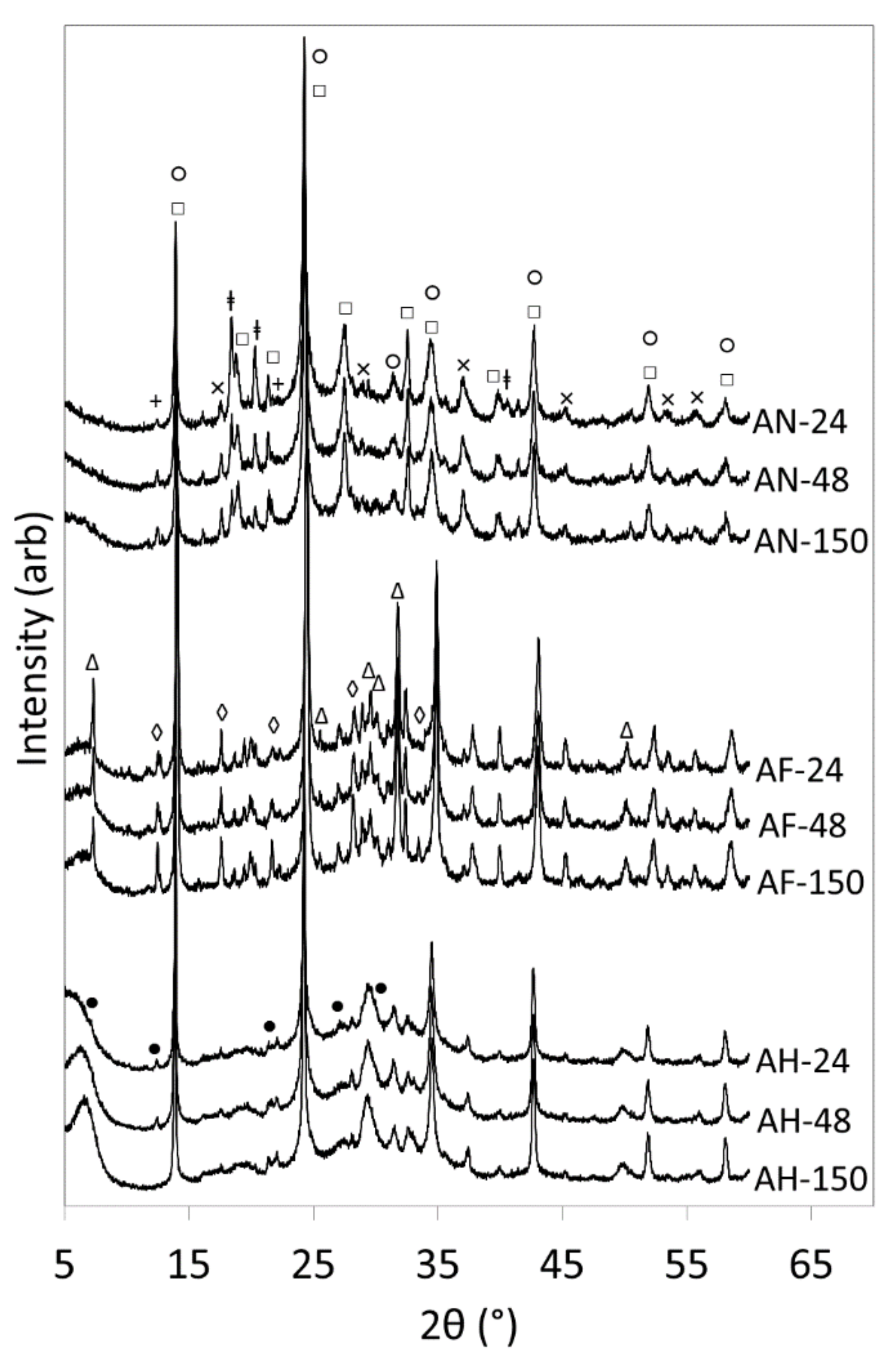
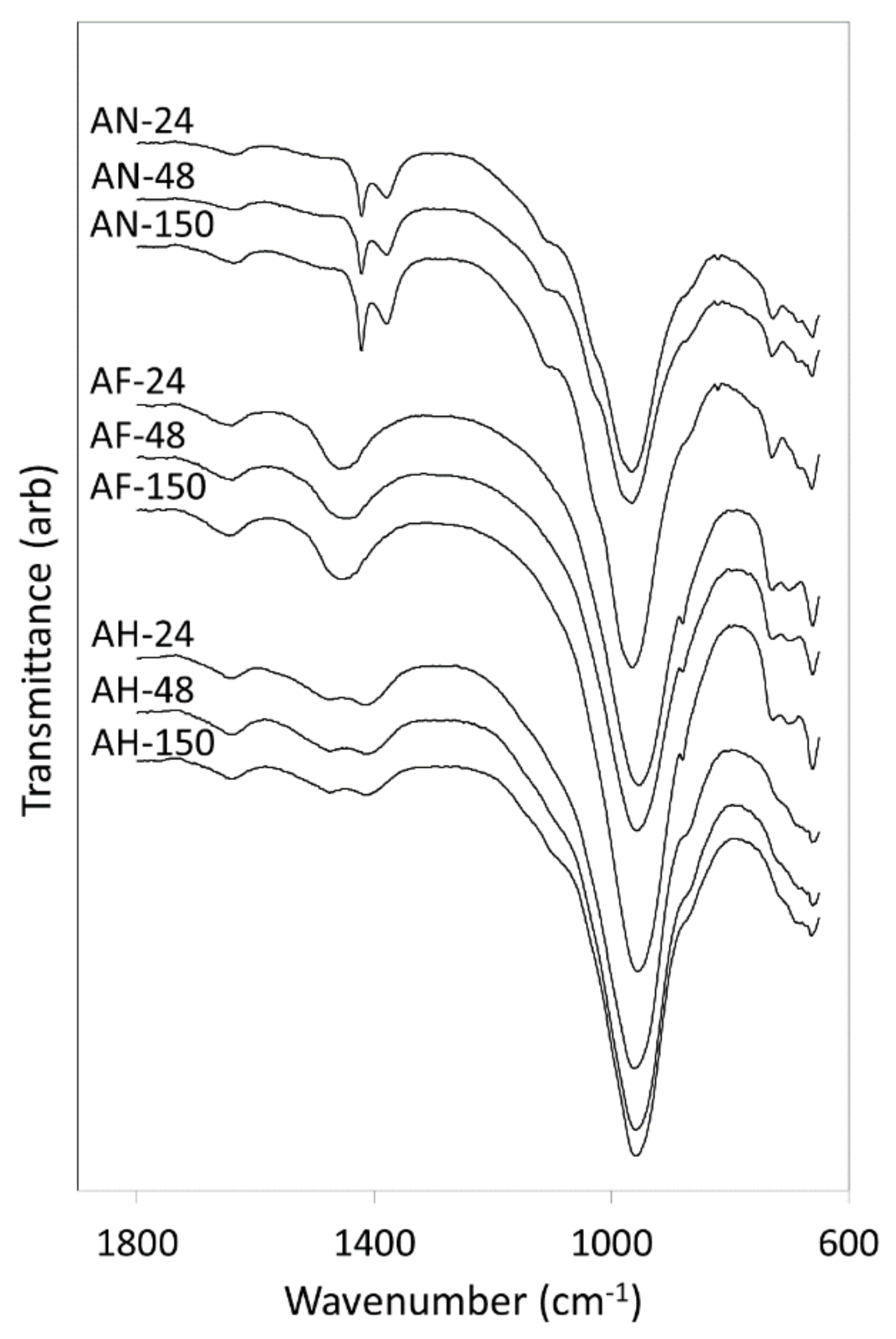



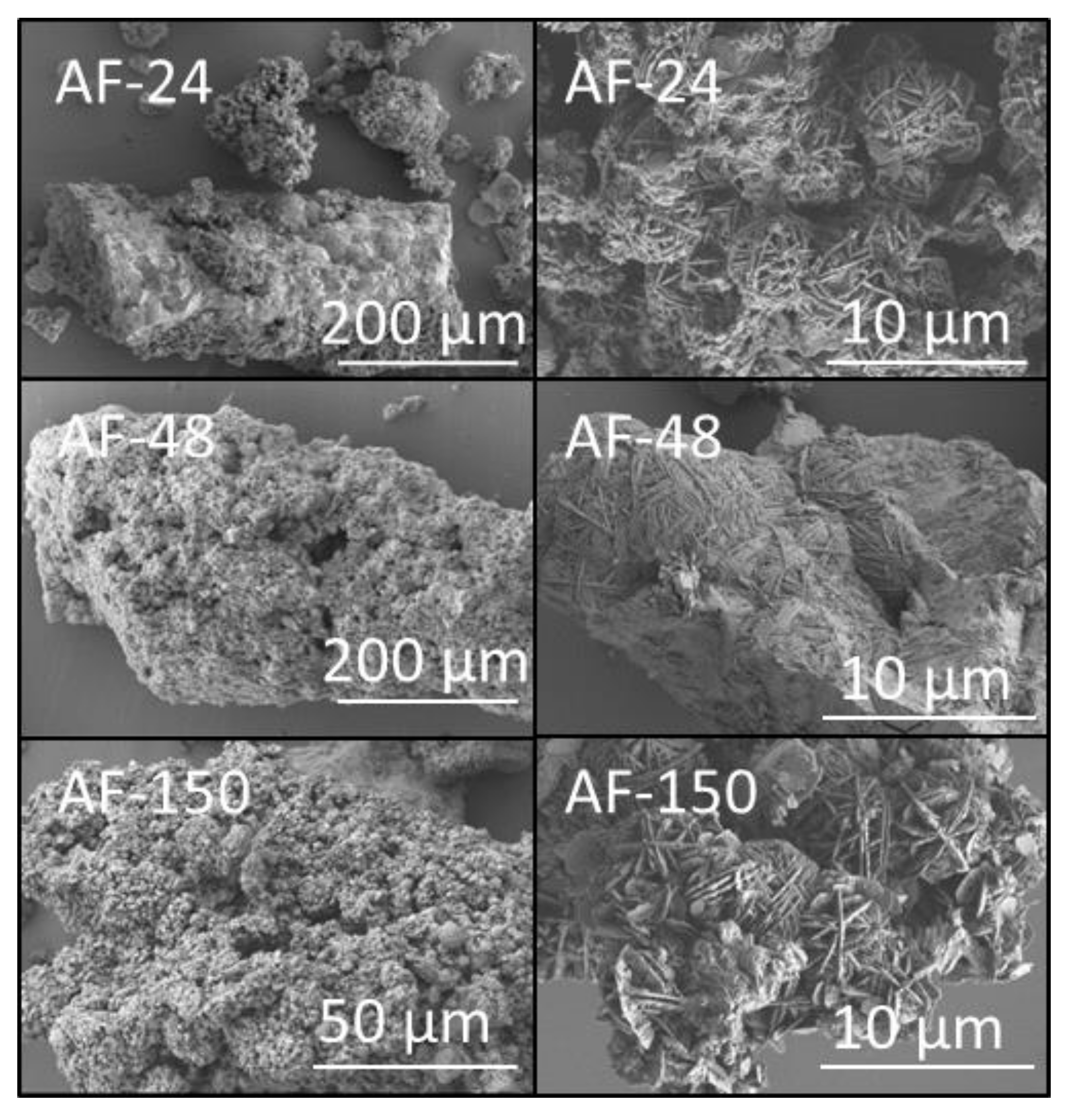
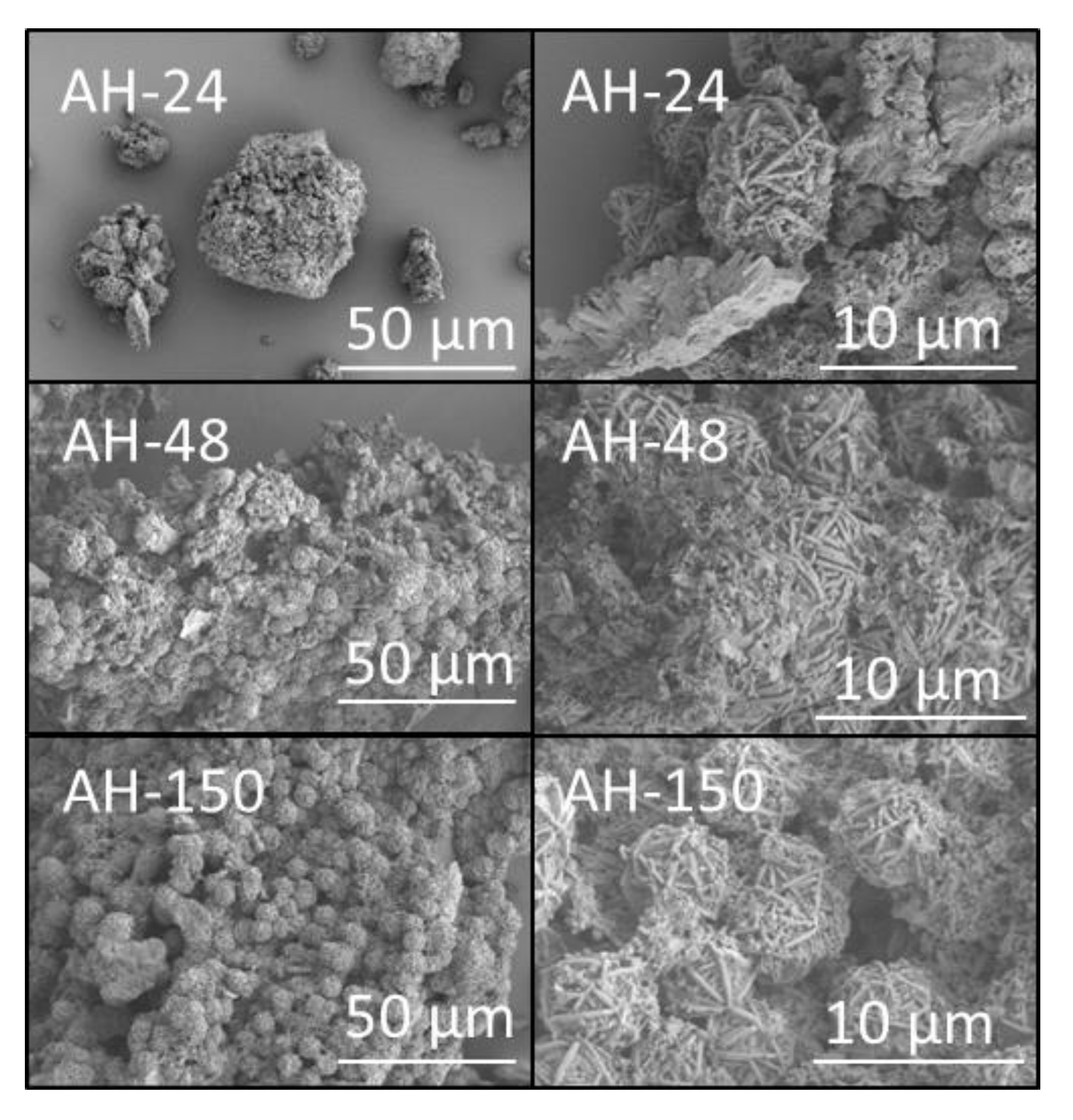
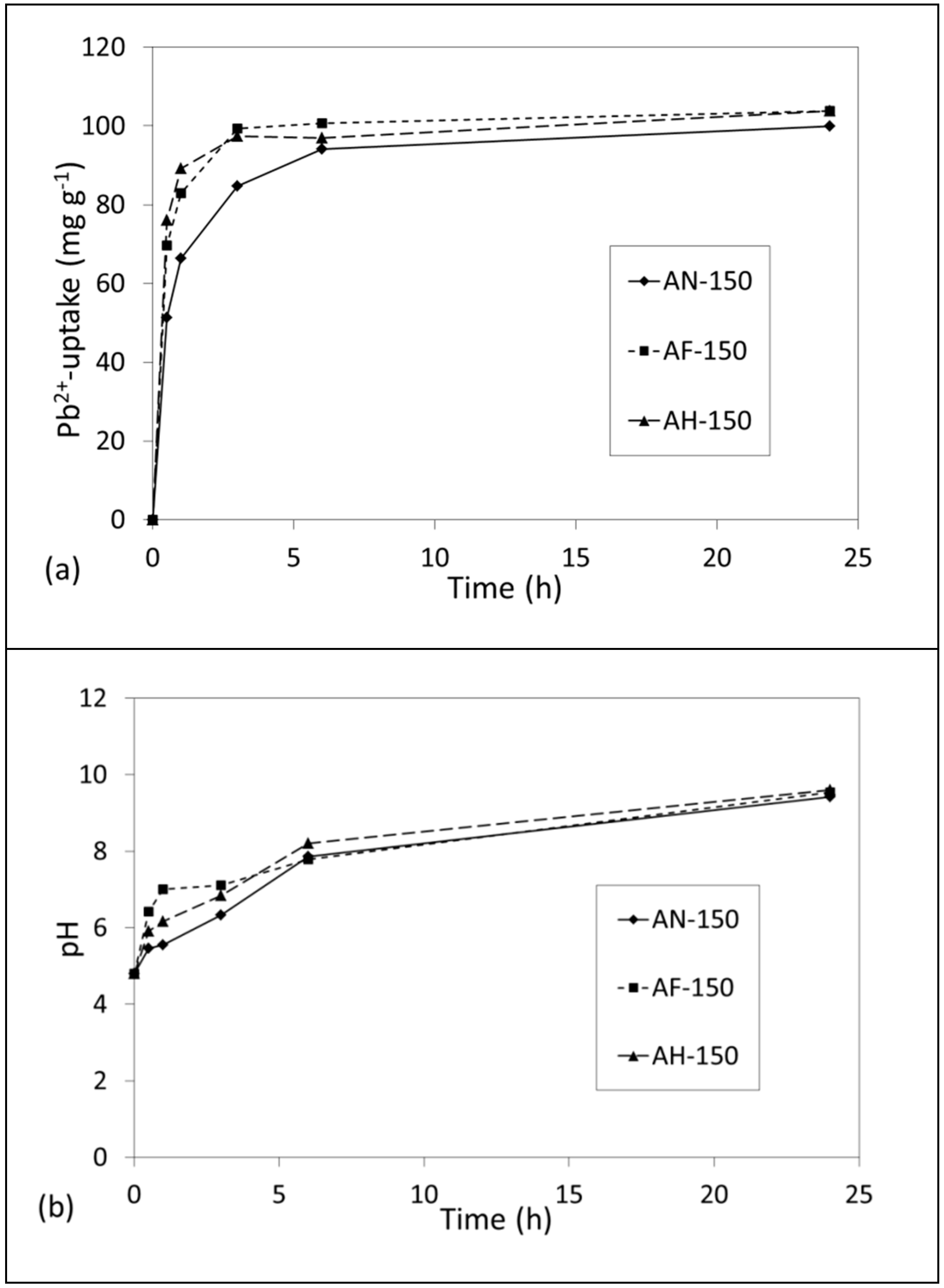


| Element | Amber Container Glass (wt%) | Aluminium Foil (wt%) | Aluminium Hydroxide Waste (wt%) |
|---|---|---|---|
| Si | 33.1 | - | 0.43 |
| Al | 1.17 | >99.9 | 22.3 |
| O | 46.4 | trace | 59.8 |
| Na | 10.2 | - | 0.29 |
| Ca | 7.17 | - | 1.23 |
| K | 0.72 | - | - |
| Mg | 0.86 | - | - |
| C | - | - | 10.5 |
| Fe | 0.30 | - | 1.44 |
| S | 0.12 | - | 3.41 |
| Cl | - | - | 0.24 |
| Cr | 0.03 | - | - |
| Sn | - | - | 0.40 |
| Phase | AN-24 | AN-48 | AN-150 |
|---|---|---|---|
| Cancrinite nitrate (PDF 01-071-2841) (%) | 42.2 | 45.4 | 48.7 |
| Sodalite nitrate (PDF 00-050-0248) (%) | 38.1 | 38.9 | 40.3 |
| Zeolite P2 (PDF 01-080-0700) (%) | 0.82 | 3.13 | 3.86 |
| Katoite (PDF 01-076-2504) (%) | 4.45 | 4.62 | 5.30 |
| Aluminium hydroxide (01-0806432) (%) | 13.8 | 7.41 | 1.75 |
| Calcite (PDF 00-066-0867) (%) | 0.62 | 0.51 | - |
| Crystallinity (%) | 45.8 ± 7.2 | 49.8 ± 0.3 | 51.9 ± 0.9 |
| Weighted profile R-factor (Rwp) | 5.69 | 5.45 | 5.43 |
| Phase | AF-24 | AF-48 | AF-150 |
|---|---|---|---|
| Sodalite (PDF 00-073-4004) (%) | 65.6 | 58.7 | 63.4 |
| Tobermorite (PDF 01-019-0052) (%) | 14.2 | 18.8 | 13.3 |
| Zeolite Na-P1 (PDF 01-071-0962) (%) | 6.15 | 9.83 | 10.1 |
| Katoite (PDF 01-076-2504) (%) | 10.4 | 8.17 | 9.23 |
| Calcite (PDF 00-066-0867) (%) | 3.70 | 4.43 | 4.01 |
| Crystallinity (%) | 60.1 ± 0.2 | 61.8 ± 0.1 | 65.0 ± 0.1 |
| Weighted profile R-factor (Rwp) | 14.5 | 14.1 | 14.9 |
| Phase | AH-24 | AH-48 | AH-150 |
|---|---|---|---|
| Sodalite (PDF 00-073-4004) (%) | 68.5 | 72.6 | 70.8 |
| Tobermorite (PDF 01-019-0052) (%) | 22.5 | 17.9 | 19.8 |
| Zeolite A (PDF 00-073-2340) (%) | 4.06 | 5.22 | 4.63 |
| Katoite (PDF 01-076-2504) (%) | 1.05 | 0.52 | 0.90 |
| Calcite (PDF 00-066-0867) (%) | 3.87 | 3.76 | 3.87 |
| Crystallinity (%) | 43.5 ± 5.2 | 45.8 ± 0.6 | 48.7 ± 0.8 |
| Weighted profile R-factor (Rwp) | 3.48 | 4.04 | 4.52 |
| Sorbent | 1Ci Range (ppm) | Solid:Liquid Ratio (mg cm−3) | 2qm (mg g−1) | 3teq (min) | Ref |
|---|---|---|---|---|---|
| Lead, Pb2+ | |||||
| AN-150 | 104 | 1 | 100 | 360 | This study |
| AF-150 | 104 | 1 | 104 | 360 | This study |
| AH-150 | 104 | 1 | 104 | 360 | This study |
| Crushed concrete fines | 1000 | 25 | 37.9 | 2880 | [31] |
| Thermally modified concrete | 5–1500 | 2–50 | 73.83 | 1440 | [32] |
| Fly ash-derived zeolite Na-X | 10–200 | 0.3 | 575 | 180 | [33] |
| Slag-derived geopolymer | 5–500 | 12.5 | 83.2 | - | [34] |
| Hydrated calcium silicate gel | 50–300 | 20 | 263 | 180 | [35] |
| Glass-derived tobermorite | 104 | 0.25 | 344 | >1440 | [3] |
| Natural glauconite | 5–220 | 12.5 | 9.12 | 180 | [36] |
| Cadmium, Cd2+ | |||||
| AN-150 | 56 | 1 | 36.5 | 360 | This study |
| AF-150 | 56 | 1 | 53.8 | >1440 | This study |
| AH-150 | 56 | 1 | 47.7 | >1440 | This study |
| Blast furnace slag | 0-5 | 0.1–20 | 5.1 | 1440 | [37] |
| Natural zeolite | 80–600 | 20–320 | 25.9 | 20 | [38] |
| Natural glauconite | 5–220 | 12.5 | 3.44 | 180 | [36] |
| Crushed concrete fines | 10–1500 | 25 | 45.2 | 7200 | [39] |
| Waste-derived calcium silicate | 200 | 2.5 | 70.8 | 180 | [40] |
| Waste-derived tobermorite | 5.6–124 | 0.25 | 179 | 8640 | [30] |
| Waste-derived calcium silicate | 100–10000 | 25 | 198 | 1 | [41] |
Publisher’s Note: MDPI stays neutral with regard to jurisdictional claims in published maps and institutional affiliations. |
© 2021 by the authors. Licensee MDPI, Basel, Switzerland. This article is an open access article distributed under the terms and conditions of the Creative Commons Attribution (CC BY) license (https://creativecommons.org/licenses/by/4.0/).
Share and Cite
Elmes, V.K.; Hurt, A.P.; Coleman, N.J. Mixed-Phase Ion-Exchangers from Waste Amber Container Glass. Materials 2021, 14, 4887. https://doi.org/10.3390/ma14174887
Elmes VK, Hurt AP, Coleman NJ. Mixed-Phase Ion-Exchangers from Waste Amber Container Glass. Materials. 2021; 14(17):4887. https://doi.org/10.3390/ma14174887
Chicago/Turabian StyleElmes, Victoria K., Andrew P. Hurt, and Nichola J. Coleman. 2021. "Mixed-Phase Ion-Exchangers from Waste Amber Container Glass" Materials 14, no. 17: 4887. https://doi.org/10.3390/ma14174887
APA StyleElmes, V. K., Hurt, A. P., & Coleman, N. J. (2021). Mixed-Phase Ion-Exchangers from Waste Amber Container Glass. Materials, 14(17), 4887. https://doi.org/10.3390/ma14174887







